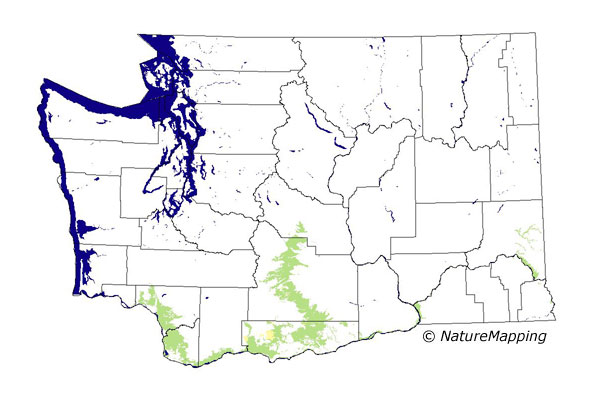 |
Metadata (Data about data or how the map was made)
Legend:
 = Core Habitat
= Core Habitat
 = Marginal Habitat
= Marginal Habitat
Predicted Distribution
Reptiles do not migrate as some birds and mammals, so the colored areas depict
the predicted range for the Ringneck Snake year-round. The habitats were identified
using 1991 satellite imagery, other datasets and experts throughout the state,
as part of the Washington Gap Analysis Project.
Other
maps & Information:
|
Distribution and Habitat Requirements
This species is most common in oak-pine regions, but it also occurs in some areas of Washington State were oaks are absent. Eggs were found in denser talus
(smaller rock and more soil) than C. constrictor eggs on an unshaded, grass-covered southern slope with several small natural rock outcrops along a hillside in Oregon.
Models
The Interior Olympic Peninsula along the Columbia river, Columbia Basin, Southeast and Southwest Cascades ecoregions were selected.
The Central Arid Steppe, Klickitat Meadow Steppe, Bitterbrush, Canyon Grasslands, Palouse, Oak, Cowlitz River and Western Hemlock zones within its range limits were core.
Good habitats were rivers and riparian areas (areas along rivers and streams), grasslands, shrublands, shrub and tree savannas and forests, except that grasslands,
shrub and tree savannas and shrublands were excluded from the steppe zones and conifer forests were excluded from the forest zones.
Model Evaluation and Comments
The number of records is insufficient to determine whether this species is now utilizing areas that were once dense conifers and currently are either hardwood or
hardwood/conifer mix forests. Its range does suggest a primarily hardwood or mixed forest association, since it seems to be mostly in areas where hardwoods are more
prominent than in many other areas of Washington.
Translated from the Washington Gap Analysis Amphibians and Reptiles Volume by Karen Dvornich
Webpage designed by Dave Lester.